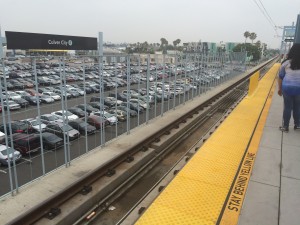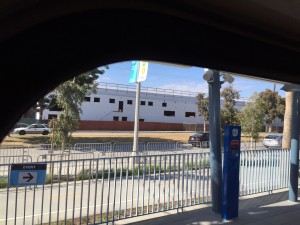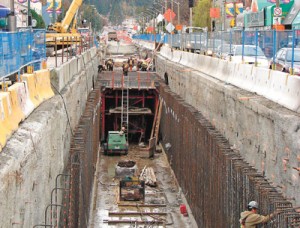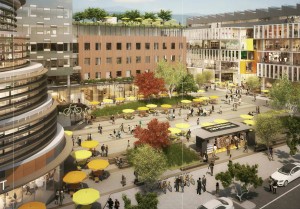First, advocate for a multi-billion transit line that will serve your home neighborhood. Then once it’s built, make sure nobody else can move to your neighborhood to take advantage of the taxpayer-funded transit line. It’s a classic bait-and-switch, and it’s happening now along the Expo Line in West L.A.
What’s at stake is an already-watered down city plan for rezoning Expo Line stations areas. The city’s “Exposition Corridor Transit Neighborhood Plan,” while rezoning some station-adjacent areas for higher density, still leaves a whopping 87% of the area, including most single-family neighborhoods, unchanged, and with too-high parking requirements to boot.
But this weak plan is still too much for Los Angeles City Councilmember Paul Koretz and his homeowner allies, including an exclusionary group of wealthy homeowners assembled under the name “Fix The City.” They oppose even these modest changes to land use in the transit-rich area. Essentially, they’ll get the financial and quality-of-life benefit of the Expo Line, while working to ensure no one else does.
As Laura Nelson details in the Los Angeles Times:
Koretz told the Planning Commission this month that the areas surrounding three Expo Line stations in his district “simply cannot support” more density without improvements to streets and other public infrastructure.
It’s a view shared by advocates from Fix the City, a group that has previously sued Los Angeles over development in Hollywood and has challenged the city’s sweeping transportation plan that calls for hundreds of bicycle- and bus-only lanes by 2035.
“It’s like when you buy a new appliance, you’d better read the fine print,” said Laura Lake, a Westwood resident and Fix the City board member. “This is not addressing the problems that it claims to be addressing.”
If Koretz and his allies have their way, their homeowner property values will go up with the transit access, but taxpayers around the region have to continue subsidizing the line even more because neighbors are not allowing more people to ride it. And to boot, they will keep regional traffic a mess by not allowing more people to live within an easy walk or bike ride of all the jobs near their neighborhood. Essentially, they force everyone else into long commutes while keeping housing prices high — an ongoing environmental and economic nightmare.
Thankfully there are others mobilizing against these homeowner interest groups, such as Abundant Housing L.A. But two things need to happen now: first, the Expo neighborhood plan needs serious strengthening, including elimination of parking requirements and an end to single-family home zoning near transit stops. Second, L.A. Metro needs to hold the hammer over these homeowners by threatening to curtail transit service to the area. I see no reason why taxpayers should continue to support service to an area that won’t do its part to boost ridership on the line.
Single-family zoning near transit is an idea that should have died long ago. It has no place in a bustling, modern, transit-rich environment like West L.A. The Expo Line bait-and-switch must end.
Falling transit ridership is a nationwide problem, but it’s particularly a setback in Los Angeles, which is investing like crazy in transit due to two recently passed transportation sales tax measures. Laura Nelson covered the recent ridership decline in the Los Angeles Times and what L.A. Metro plans to do about:
Metro bus ridership fell 18% in April compared with April 2015. The number of trips taken on Metro buses annually fell by more than 59 million, or 16%, between 2013 and 2016.
A recent survey of more than 2,000 former riders underscores the challenge Metro faces. Many passengers said buses didn’t go where they were going — or, if they did, the bus didn’t come often enough, or stopped running too early, or the trip required multiple transfers. Of those surveyed, 79% now primarily drive alone.
In an attempt to stem the declines, Metro is embarking on a study to “re-imagine” the system’s 170 lines and 15,000 stops, officials said. Researchers will consider how to better serve current riders and how to attract new customers, and will examine factors including demographics, travel patterns and employment centers.
Meanwhile, as Metro explains in its outlet The Source:
Metro has not embarked on such a systemwide effort since the 1990s so it is timely given the significant expansion of the Metro Rail system this century, growth of municipal operator services and the popularity of other transportation options (i.e. ride hailing services such as Lyft and Uber).
As I blogged earlier, it was easy to dismiss prior reports of falling ridership, but now is definitely a good time to take it seriously.
But Metro won’t exactly be hurrying to get to the bottom of this. The bus system review isn’t planned to be completed until April 2019, which will then require public hearings later that year. So any actual changes won’t go into effect until December 2019 — at the earliest.
Two years seems like a really long time to study this issue, although Los Angeles does have an enormous system. Still, a little urgency could be in order. And in the meantime, the agency could focus on one immediate step that is guaranteed to boost ridership: require local governments with major transit stations to relax restrictions on adjacent development.
And Metro could start with the recalcitrant neighborhoods around the new Expo Line.
Otherwise, we’ll have to wait a while on any results from the bus study.
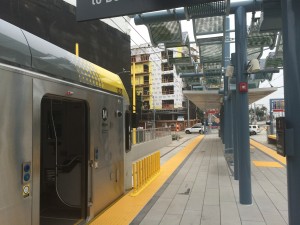
New apartments by the downtown Santa Monica station, which ain’t happening hear other stations along the Expo Line.
The Expo Line from Downtown L.A. to Downtown Santa Monica travels a highly congested corridor in the job-rich but housing-poor Westside of L.A. While the multibillion rail line has been successful so far in exceeding ridership projections, it could still fail to live up to its full potential unless the station neighborhoods allow more compact, rail-oriented development to generate enough riders for the line and minimize the taxpayer costs. Not to mention this part of town badly needs housing in areas that don’t require car commuting.
So it was a big deal last month when the City of Los Angeles released the draft Exposition Corridor Transit Neighborhood Plan, which governs the land use for the neighborhoods around the line within the City of Los Angeles.
Steven Sharp over at Urbanize LA took a deep dive into document. His verdict? The plans are tepid at best with no strong vision for the kind of density required to make good use of the multi-billion rail line:
While a small but significant step towards a more transit-oriented future for communities surrounding the Expo Line, the Expo TNP [transit neighborhood plan] falls short in terms of scale and scope when compared to planning around rail lines in other major cities.
On the opposite side of the country, Washington Metro stations are surrounded by dozens of walkable town centers in southern Maryland and northern Virginia. Other existing commercial hubs, such as Tyson’s Corner, are being gradually retrofitted for pedestrians following the introduction of passenger rail service.
In contrast, the proposed Expo TNP walks a fine line between maintaining the status quo and creating the transit-oriented communities implied by the project’s name. The station subareas which would be rezoned for higher density development represent less than 13 percent of the total land area encompassed by the Expo TNP, as the vast majority of properties are excluded from land use changes on account of their R1 and R2 zoning.
The properties that would be upzoned under the plan are almost exclusively commercial and industrial sites, where current occupants are less likely to oppose new construction. Although a change in land use may be appropriate for these properties due to the arrival of the Expo Line, the fact that wealthier residential blocks nearby were left untouched speaks to the continued political clout of Los Angeles’ homeowners. This is perhaps best highlighted by the Westwood/Rancho Park Station, which is surrounded on all sides by million-dollar houses, and was more-or-less ignored by the Expo TNP.
All of which makes me want to renew my call to shut down or otherwise reduce service to under-performing stations along the line. If the locals are not going to allow appropriate development in these choice areas, then these stations shouldn’t slow riders traveling from the dense downtowns on either end.
Last week I finally got a chance to ride the new Expo Line extension to Santa Monica, and here are some takeaways:
-
Many stations have lots of free parking, with the sheriff’s office patrolling the lot I used in Culver City (see photo). This is a bit of a shock coming from the Bay Area, where BART parking costs money each day. So evidently demand is not that great, if Metro can afford to give this resource away for free. Ultimately this land would be better used as office and housing rather than expensive parking stalls for car drivers.
- Farmdale and the Westwood stops are basically pointless and should be closed down at least temporarily. Farmdale was created by a legal settlement solely to slow the trains down. Westwood is in a single-family residential neighborhood with what appears to be no hope for urban-style development. Any buses down Westwood (a heavily traveled boulevard) could intersect with Expo at a neighboring stop instead, like at Sepulveda.
- The Expo bike path didn’t seem to be heavily used. I rode the line both mid-day and during the afternoon commute time, but the adjacent new bike path was only used by the occasional jogger, as far as I can tell. I gather they’ll need to do a better job finishing the missing gaps in the bike lane, but in the meantime it seems like a huge opportunity for bike advocates to promote. Notably I saw a lot of people with bikes on the train — more than I’ve noticed on Bay Area trains.
- LA’s train culture and etiquette is still evolving. It’s a different thing to get used to traveling on a train with others instead of driving solo. At one point an elderly man with a walker tried to get on a jammed train, but nobody would scoot in towards the center of the car to let him on, despite another rider urging everyone to do so. “Sorry,” the rider told the man loudly as the doors closed. “Evidently this is a train full of A-holes.”
- But on the positive side, I saw a number of friendly interactions, such as the elderly couple sparking a conversation with a pregnant mom and two friends who happened to bump into each other on the train platform.
- The end-to-end travel time is worse than advertised. It took me 53 minutes to get from Santa Monica to downtown LA, worse than the estimated 46 minutes.
-
Lots of good development happening in downtown Santa Monica. I was pleased to see all the new apartment buildings going in right by the station (see photo). Those will be some lucky residents, being able to stroll down to the train from their homes and get east quickly.
Overall, despite some of these negative observations, it was pretty thrilling to ride the line. The views of neighborhoods I’d never seen before reminded me of how nice it can be to watch the world go by from an electric train, with a smooth ride and an opportunity to explore parts of the city you’d never see otherwise. And it was great to parallel Interstate 10 in parts while the freeway was badly congested.
So there’s a lot to be excited about with the new lines, but definitely a lot of room for improvement, too. It will be fun to watch the Expo Line, as a brand new, fully-built train route, settle in to the Westside.
The media coverage of the Expo Line to Santa Monica’s slow travel speed has been increasing. KPCC radio ran a segment describing the slow speeds and desire to give the trains signal priority in downtown Los Angeles.
Meanwhile, my proposal to have Metro consider shutting down under-performing stations generated some pushback. I’ll summarize the main arguments against here:
1) It’s too soon. The line just opened, and the stations may yet generate more ridership if we just wait a while.
My response: with something like ridership, it’s not just a matter of “getting the word out” or waiting for people to eventually figure out that the train is good for them. Ridership instead is a function of the land use around the stations and how densely packed the area is with jobs and housing. In the case of under-performing stations, the land use isn’t going to change right away. So while we wait for new developments, why continue serving the station if it slows the ride for everyone while providing relatively little benefit?
Bonus benefit: shutting the stations gives the locals an incentive to actually permit new construction. Right now, they have no incentive to do so and instead every incentive to cater to the usual “parking and traffic concerns” homeowner crowd.
2) It may hurt ridership overall to shutter the stations, and it’s supposed to be a “community” line — not a downtown-to-downtown line.
My response: I agree it may hurt ridership, which is why I suggest that Metro study the closures. If the relative improvement in travel times doesn’t produce enough new riders to cover the decrease in ridership from the closed stations, then it’s not worth pursuing. Case closed. But it may also require a temporary closure to get real-world data on ridership impacts.
And let’s not forget, downtown Los Angeles and downtown Santa Monica are major destinations that require speedy service between them.
3) Sheesh, the line just opened. Don’t jump to conclusions so quickly.
It may seem like a hasty conclusion, but the fact is that many of us foresaw this issue years ago. From my book Railtown (published 2014, but this passage was written in 2012):
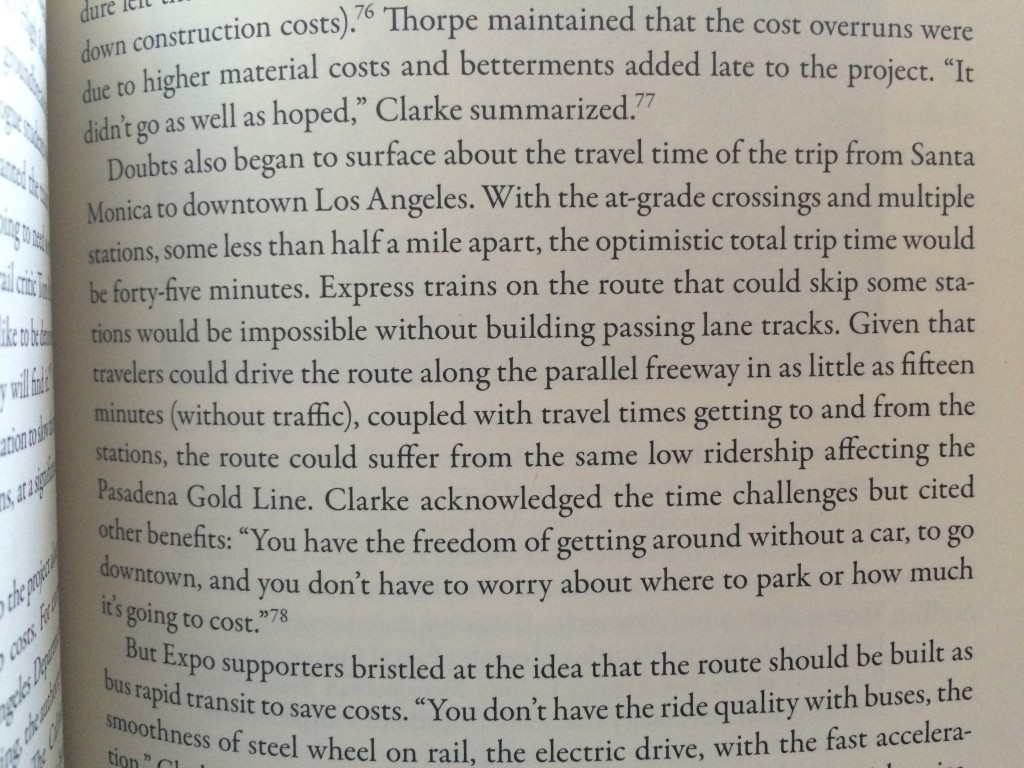 Furthermore, the Expo line was deliberately over-stationed precisely in order to slow the whole train. Again from Railtown:
Furthermore, the Expo line was deliberately over-stationed precisely in order to slow the whole train. Again from Railtown:
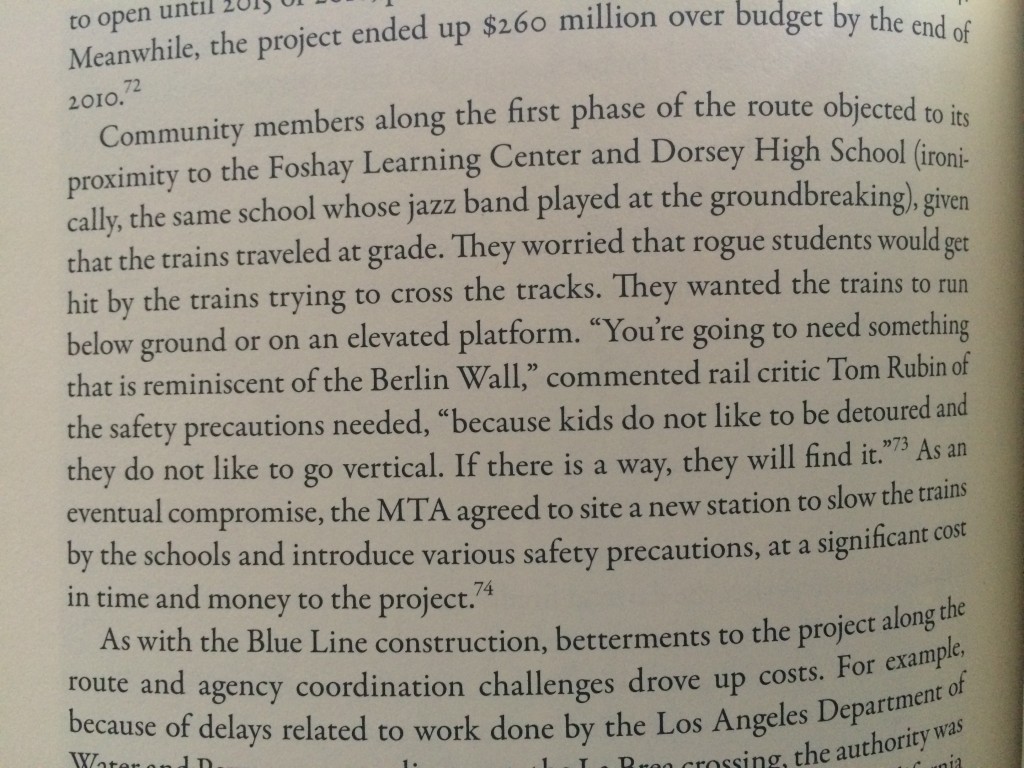 So I understand why some people thought this call was a hasty over-reaction. But the reality is that this issue has been brewing for a long time. And now that the public is finally riding the line, they’re experiencing the consequence of many poor decisions made over the years.
So I understand why some people thought this call was a hasty over-reaction. But the reality is that this issue has been brewing for a long time. And now that the public is finally riding the line, they’re experiencing the consequence of many poor decisions made over the years.
As I feared, the travel time from downtown Los Angeles to downtown Santa Monica on the newly opened Expo rail line is worse-than-advertised, and the media is starting to notice. Joe Mathews has a very fair (and fairly depressing) account of his four-hour-plus commute from Pasadena to Santa Monica, worse than his typical three-hour commute by car:
The switch to the new Expo Line at the Metro Center station for the third leg of my trip was smooth. But the Expo Line was painfully slow. Metro had advertised a 48-minute ride, but it took more than an hour. The track runs down the middle of streets—and the train stops for traffic lights at some intersections. In Santa Monica, after a six-block walk, I arrived at work two and a half hours after I had reached the Pasadena station—25 miles away. In that same time, I could have flown to Las Vegas, played the airport slots, and flown home, jackpot in hand.
To be sure, the opening of the regional connector through downtown will certainly shave off travel time for riders like Joe. And if the City of Los Angeles can change the signal priority and street configuration, the trains will run a bit faster through downtown.
But otherwise, we’re left with a slow line, absent further infrastructure improvements like extra tracks to run express trains that can skip slow trains or more grade separation, like bridges over intersections. But those improvements cost money the region doesn’t have and won’t spend even if they had it, given how much Expo already cost to build and competing transit needs across the county.
So what’s the solution? The cheapest one is to shut down under-performing stations along the line. For anyone who’s ridden the line, it’s obvious there are some station areas that are low-rise and therefore low-ridership. Absent further development around them, Metro should shut them down and speed the ride for the majority of riders.
On the new extension, here are the initial ridership figures from one of the first days in service:
Palms: 1,016 TAP entries.
Westwood/Rancho Park: 661 TAP entries.
Expo/Sepulveda: 1,150 TAP entries.
Expo/Bundy: 1,376 TAP entries.
26th St/Bergamot: 853 TAP entries.
17th St/SMC: 1,020 TAP entries.
Downtown Santa Monica: 5,982 TAP entries.
If these trends continue, Metro should consider shutting down Westwood/Rancho Park and 26th Street/Bergamot on the new extension. (There would be particular irony in shutting down the 26th Street station, as local NIMBYs and their representatives on the city council prevented that station from becoming a thriving transit hub and instead relegated development to a suburban-style office park — see photo on the right of the building under construction).
Meanwhile, ridership data on the first phase of the extension to Culver City should inform which stations are shut down there. (Notably, one station on that phase was required as part of a legal settlement, which could complicate a shutdown effort for at least that station.)
The Expo Line runs 15.2 miles, and it shouldn’t take an hour. 15 miles per hour just isn’t providing much benefit over driving, if any. And it won’t make the line sustainable in the long run. So that’s why policy makers need to consider immediate action to improve the travel times.
In the hand-wringing over the Expo Line to Santa Monica’s slow travel times, Kerry Cavanaugh of the Los Angeles Times argues that transit like Expo shouldn’t have to deal with automobile traffic:
The long-term answer, however, is grade separation. Trains can run faster and more safely and stay on schedule if they don’t have to cross paths with drivers, pedestrians and cyclists. (KPCC-FM (89.3) analyzed Metro data and found that, no surprise, the underground subway lines have the fewest delays.)
Of course, it’s more expensive to build grade-separated rail or to retrofit an existing system. An overpass can cost as much as $20 million, one official estimated. But as L.A.’s rail system expands in an increasingly dense, traffic-clogged urban area, it’s penny-wise and pound-foolish to build lines that have to stop at red lights and share the road with cars.
She rightly points out that these trains should also have signal priority to avoid getting stuck at red lights.
It’s obviously a better deal to have grade separation in terms of reduced travel times — and it’s much safer for pedestrians and other drivers as well, not to mention for the transit riders in the train cars that get hit.
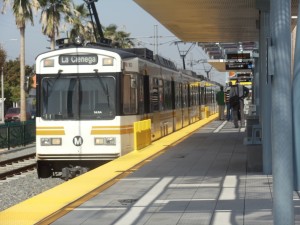 But the problem with grade separation, as Cavanaugh acknowledges, is that it’s very expensive to build lines that run above or below street level. And retrofitting the newly opened Expo Line to either trench the line through downtown Los Angeles or go aerial is essentially infeasible at this point. First, it would cost money that Metro doesn’t have. And second, it would require essentially mothballing the existing train line in whole or in part for a few years during construction.
But the problem with grade separation, as Cavanaugh acknowledges, is that it’s very expensive to build lines that run above or below street level. And retrofitting the newly opened Expo Line to either trench the line through downtown Los Angeles or go aerial is essentially infeasible at this point. First, it would cost money that Metro doesn’t have. And second, it would require essentially mothballing the existing train line in whole or in part for a few years during construction.
This same challenge is evident in the calls to convert the Orange Line busway in the San Fernando Valley to light rail. If the construction upgrade happens, the busway will be out of service, causing a major headache for transit riders.
The best solution is to simply build the best line from the start. And given that transit funds are scarce in a region as big as Los Angeles, that means focusing on low-cost solutions like signal priority and the ability to close down under-performing stations to speed up travel for everyone else, or double-tracking parts of the line to allow express trains to pass slower ones (which may be cheaper overall than grade separation).
Demanding grade separation in new projects is a good idea, but even then transit advocates will likely have to compromise it away in the name of fiscal responsibility. So they should think through low-cost but effective backup plans early on to ensure speedy and reliable service.
The groundbreaking ceremony for the just-opened Expo Line light rail to Santa Monica took place back on September 29, 2006. I was there and got this cool mini shovel memorabilia to honor the occasion:
That means that the opening of the full line to Santa Monica on Friday happened just under 10 years after groundbreaking. For those keeping score at home, that means the Expo Line Construction Authority managed to build 1.5 miles of rail each year.
As far as rail lines go, this should not have been a very complicated construction job. The line runs virtually entirely at-grade, with minimal trenching and a handfull of overpasses. In addition, the right-of-way already existed and therefore required relatively little property acquisition and condemnation.
In short, the amount of time spent to build this line seems absurd. That’s not even counting the years of planning. And yet the region’s leaders apparently aren’t upset by it or demand any better.
Sadly, at this point, Californians have just gotten used to these interminable construction timetables. High speed rail is way behind schedule and won’t open until probably the 2040s or 2050s, if at all. The Purple Line subway extension down Wilshire most likely won’t be operational until the 2030s. Even automobile projects like the San Francisco Bay Bridge eastern span took over a decade to open.
It’s a subject I tackled for UCLA Law in 2014, with the report Back in the Fast Lane, and an op-ed in the San Francisco Chronicle. Yet I’ve seen little interest among policy makers (or even the public) to tackle this issue. Why the complacency?
For those who care about boosting transit, they have an interest in getting ahead of this problem. A few bad headlines can undermine political support for transit investments, especially in California where advocates need two-thirds voter approval for tax measures. And it also means we’re getting much less bang for our buck on these projects, which means fewer projects that benefit people.
It’s enough to make me mad. Or maybe it will later. At some point anyway.
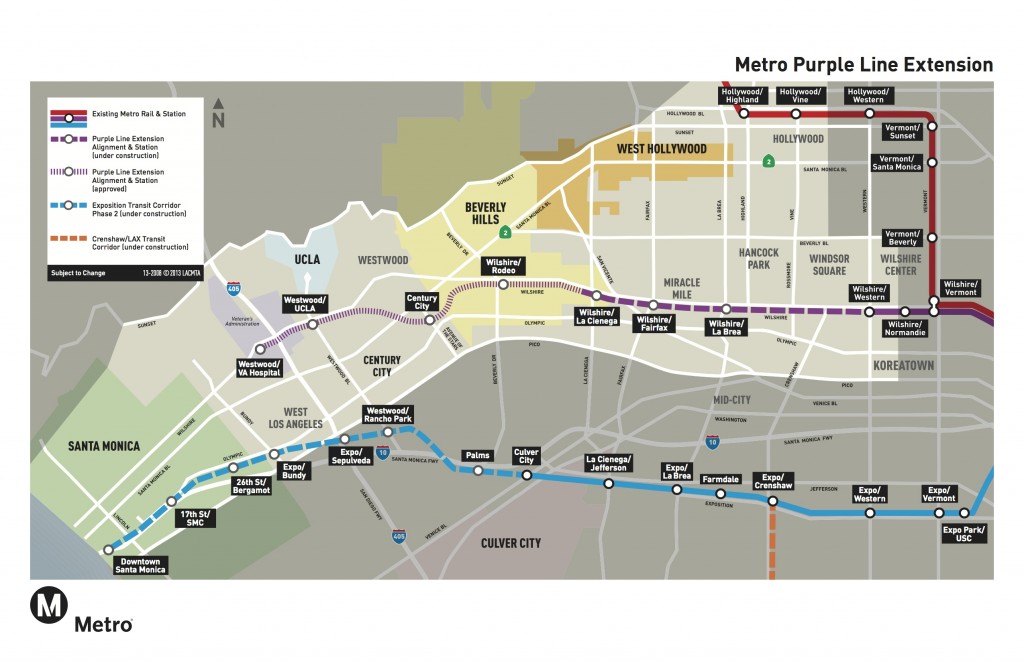 Time to fill in the dotted blue dots on the Expo Line map above to Santa Monica: as of today at noon, they’ll be solid blue as the route becomes operational.
Time to fill in the dotted blue dots on the Expo Line map above to Santa Monica: as of today at noon, they’ll be solid blue as the route becomes operational.
So what’s next? Here’s what I’ll be looking for in the months (and years) to come:
- Long travel times: will people be frustrated by the nearly hour end-to-end ride from downtown Santa Monica to downtown L.A.? Current time projections are 50 minutes, which is a long time for a ride that can take 15 minutes by car with no traffic. The LA Weekly and Los Angeles Times have done a good job of flagging this issue. There are no easy solutions, but at a minimum the City of L.A.’s transportation department should give the trains signal priority so they don’t stop at red lights downtown. Meanwhile, Metro should consider skipping under-performing stations, at least temporarily.
- Collisions: with the train running most at-grade (i.e. street level) and going through some funky intersections from the old railroad right-of-way, will the line experience a lot of accidents like the similarly situated Blue Line, one of the deadliest in the country? And what will the political response be? Easy solutions would be more crossing gates to block traffic, including for those driving in the wrong lane who try to get around single-lane crossing gates (it happens).
- The Expo bike lane: part of the rail extension includes a badly needed dedicated bike path. There’s a gap in the route though, apparently due to neighborhood opposition (what’s new). But the conditions are ripe to make this path even more successful, on a per traveler cost basis, than possibly the rail line next to it. The route is largely flat, the weather is great, and biking is super convenient. So this may be the unsung hero in the whole project.
-
Transit-oriented development along the route: the whole point of rail lines is really about economic development and land use, as Politico covered in an excellent profile on Denver’s burgeoning rail network. Right now, the route covers a lot of relatively low-density areas, and Santa Monica infamously shot down an office and housing project (see rendering) next to one of the new stations, resulting in a low-rise suburban office park to take its place. Will the cities along the route allow new development near the stations? If not, the line will be doomed to under-performance.
- Changing the politics of rail in Los Angeles: with rail now serving a highly visible, major job center in the region, will its existence solidify rail as a politically entrenched force? A bus activist in the Bay Area once told me that nobody would ever scale back BART in favor of buses now, because “BART is too precious.” Will the same thing happen to Metro Rail? As the system begins hauling more people and possibly taking a central role in economic development (subject to #4 above), it may lock in ongoing voter support for the foreseeable future. And not just in the westside. After all, with the eastern county Gold Lines operating, many of those residents will have a stake in accessing jobs in the western part of the county, too.
I’m sure other issues will arise as the system matures, and I’ll try to follow them on this blog. But for now, something to consider as many westside workers and residents of Los Angeles finally get their day to ride the rails.
Los Angeles is about to unveil one of the most consequential transportation projects in recent history. I don’t want to get too hyperbolic, but the coming of the Expo Line light rail transit tomorrow to Santa Monica is, as our current vice president might say, a big f***** deal.
The reason for the import is twofold: first, the location. The westside of Los Angeles County is the most densely populated in the region and the most traffic-choked. Expo, running from downtown Los Angeles all the way to the beach, will finally open that area up to the rest of the train network that’s been growing in fits and starts since 1990. That means a good ridership boost for the whole system and a major alternative to driving for many westside residents and workers.
 Second, and more intangibly, the train will now serve an influential part of the population, who will finally be seeing a train in their backyard, and a highly visible location for tourists and Angelenos alike.
Second, and more intangibly, the train will now serve an influential part of the population, who will finally be seeing a train in their backyard, and a highly visible location for tourists and Angelenos alike.
Some of the most wealthy and powerful people in Los Angeles, from business to media to opinion leaders, reside in the westside. They are the ones who set much of the tone for the region in its popular discourse and are key to much of its politics and private investment, particularly during a time of tremendous income inequality. As opinion shapers, it matters if they complain about LA “not having any transit” (leaving aside the comprehensive bus network), so a train in their backyard undermines that claim.
In addition, with trains running through the streets of Santa Monica and along Interstate 10, this line will be a visible symbol of the ongoing transformation in Los Angeles’s housing patterns, transportation options, and self-image. Some of the most powerful people in the region will be seeing it firsthand, as well as the legions of tourists from around the world (and the region) who visit downtown Santa Monica and nearby areas.
Ultimately, actions and investment matter more than symbols, and the everyday county voter has certainly been the key to funding these investments. But images and impacts are mutually reinforcing, and the symbolism of Expo — as much as the ridership boost and potential for neighborhood development along the corridor — may matter just as much in the long run.
All in all, it makes tomorrow a momentous day in the history, and future, of transportation and development in Los Angeles.

